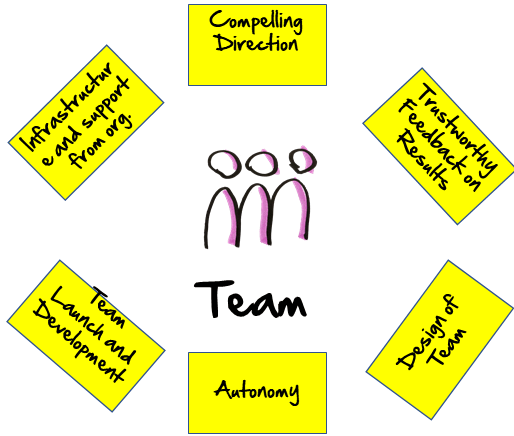Team Size and Clear Boundaries
Let’s say that you have some really interesting but very challenging work coming up. You have created a plan as a team, and you notice that as you are about to get started you feel energized and that you were actually looking forward to it. A week into the project one of your teammates is suddenly missing and you find out he is taking a month off at the Bahamas and it seems that chances of meeting your goals are now close to zero. Most people will have a very hard time to keep contributing at their fullest potential in a situation like that. Why would you give it your best shot when the people that are jointly responsible clearly does not?
Indeed, as pointed out by Christopher Avery[5]: The motivation of a complete team is usually set by the least invested/motivated team member. The least inspired person tends to drag everyone else down to the same low level of engagement. Hackman also mentions the related phenomena of “Social Loafing”, someone “free riding” along and not contributing their share of the work.
A common cause for this problem is the habit in many organizations of assigning people part time to several teams, or to set things up so that teams are dependent on external experts with no commitment to the team.
The way to prevent this is to set clear boundaries for the team. A team need to know who is on the team and who is not. Who can I count on when going gets tough and who may have other priorities?
Basically, to get this working in a software development context, we need teams with full time team members. To make this easier to achieve, you may want to consider keeping teams intact and letting existing teams take on whatever projects/work that comes up rather than starting up a new team for each new project.
To avoid “Social Loafing”, also try to make the team as small as possible. If a team have barely enough people to manage finish their task, the likelihood of anyone “free riding” decreases. Coordination is also much easier than on a large team. If a handful of persons can get the job done, this is a good size to aim for.
Interdependence
Surprising to some, the ideal in an agile team may not be that everyone is able to perform every task. From a teamwork perspective it is actually better if people have different skills, so that they will actually have to work together to accomplish the team goals.
This also aligns nicely with the idea of “T-shaped” people. We want people that have deep expertise in some area. This is what enables us to create products with great performance. Only relying on experts tend to take too long though. There will be lots of waiting times as they pass work between each other, and the opportunity may be gone as we finally manage to get the product out the door. If instead people are experts, but also are willing to help out with things that they do not master so well every now and then, we can achieve speed in development also.
The way to get this working is to assign sufficiently big things to teams so that a multitude of skills is needed to perform the work. Ideally teams should not just “implement requirements”. They should have the greater task of creatively striving to solve some customer problems, or to optimize value to customers in some area. Stability over time Team development models usually include some kind of phases, such as “Forming, Storming, Norming and Performing” by Bruce Tuckman, or the phases 1-4 as defined by Susan Wheelan. They indicate that it takes a bit of time to get a new team going. In the beginning the team will be struggling with everyone finding their roles and ways working together. As you sort that out the team will eventually be able to deliver more value than what the team members were able to do if they had been working as individuals. This can easily take 6 months or even a year.
So, you may want to consider keeping teams together for longer times. To make this possible, think about assigning projects/work to existing teams rather than forming a new team for each new endeavor.
Some techniques to address this condition
Team self-selection
Move from project teams to stable teams with full time team members
Assigning larger, value/effect based, goals to teams, see compelling directions chapter
Activities for Teambuilding
Perhaps the most common activities for team building are going bowling and then continuing with dinner & drinks. Or perhaps solving a puzzle such as an “Escape room”, trying to instill teamwork by doing something completely different than regular work. This can be fun and all, but these activities probably fall into the category of 5/9 activities that produce no measurable improvement in teamwork according to Susan Wheelan. So feel free to keep offering fun stuff like this to employees, but do not count of this as the foundation for team building.
What works then?
Well, some of the activities from previous sections, such as processing and agreeing on direction/goals on product-, organization, team and individual levels are major team building activities. The team cannot self-manage if they do not feel the direction is motivating. Also, team members will only contribute to their full potential when they feel the direction is compelling.
An agile team also needs to learn some new skills in order to be self-managing/self-organizing. Especially they need to learn how to:
Quickly make good enough decisions as a team
Solve problems as a team
Navigate conflict as a team
Having some of these skills is of help since teams also need to decide
Ground rules for working together
Specific ways of working that all team members at least agree to. (Consent decision making is enough here, not consensus)
In the Google Aristotele team-research they found “Emotional Safety” (aka trust) to be the best predictor of team performance. Emotional safety basically means that you can show up as your full self at work. You can be yourself and do not have to put on a mask or protective armor because you know that nobody will try to hurt you. This is probably factors that most team building activities tries to address with various social off-work social activities. Maybe that even helps a little, but by using job focused specific activities, some listed below, this can be taken to a completely different level.
Related exercises from part 2
Individual Goals
Organizational Goals for Teams
Product Goals for Teams
Team Vision
Ground Rules & Decision Making
Journey Lines
Roles-and-Expectations
Appreciation Cards
Balancing Team- and Individual work
Market of skills
Repairing Broken Agreements
Infrastructure and support
Here are some ideas on question you can ask to check the level of infrastructure and support you currently have for your teams:
Do they have easy access to all information they could use to maximize the value of their work?
Do they have the tooling they need and is tool-performance top class?
Do they have the personnel and physical space needed?
When there is tooling or infrastructure problems, how quickly can the team get help?
When the team discover a need for learning, can they quickly get the resources needed to do so?
Do the reward system of the company encourage teamwork or individual hero behavior?
Do the organizational design foster collaboration between groups and departments?
When the organizational design creates conflict between organizational parts, do managers have the sophisticated political and interpersonal skills, persistence, inventiveness and sense of timing to help resolve this?




